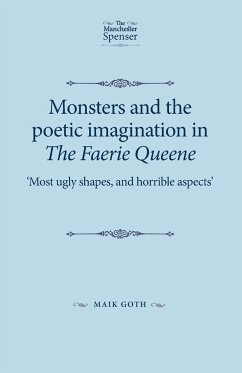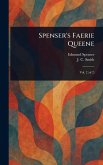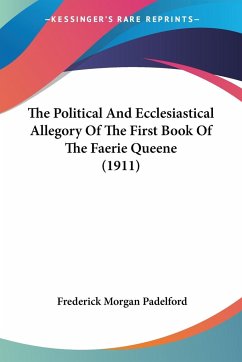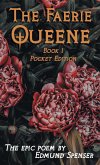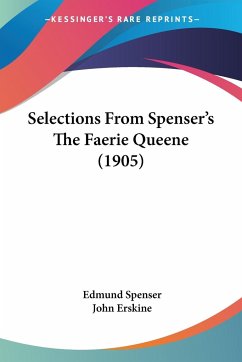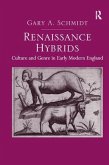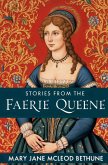Maik Goth
Monsters and the poetic imagination in The Faerie Queene
'Most ugly shapes, and horrible aspects'
Maik Goth
Monsters and the poetic imagination in The Faerie Queene
'Most ugly shapes, and horrible aspects'
- Broschiertes Buch
- Merkliste
- Auf die Merkliste
- Bewerten Bewerten
- Teilen
- Produkt teilen
- Produkterinnerung
- Produkterinnerung
The first ever book-length account of Spenser's monsters and their relation to the poetic imagination in the Renaissance.
Andere Kunden interessierten sich auch für
![Spenser's Faerie Queene Spenser's Faerie Queene]() Edmund SpenserSpenser's Faerie Queene34,99 €
Edmund SpenserSpenser's Faerie Queene34,99 €![The Political And Ecclesiastical Allegory Of The First Book Of The Faerie Queene (1911) The Political And Ecclesiastical Allegory Of The First Book Of The Faerie Queene (1911)]() Frederick Morgan PadelfordThe Political And Ecclesiastical Allegory Of The First Book Of The Faerie Queene (1911)19,99 €
Frederick Morgan PadelfordThe Political And Ecclesiastical Allegory Of The First Book Of The Faerie Queene (1911)19,99 €![The Faerie Queene The Faerie Queene]() Edmund SpenserThe Faerie Queene13,99 €
Edmund SpenserThe Faerie Queene13,99 €![Selections From Spenser's The Faerie Queene (1905) Selections From Spenser's The Faerie Queene (1905)]() Edmund SpenserSelections From Spenser's The Faerie Queene (1905)25,99 €
Edmund SpenserSelections From Spenser's The Faerie Queene (1905)25,99 €![Renaissance Hybrids Renaissance Hybrids]() Gary A. SchmidtRenaissance Hybrids179,99 €
Gary A. SchmidtRenaissance Hybrids179,99 €![The Faerie Queene The Faerie Queene]() Edmund SpenserThe Faerie Queene34,99 €
Edmund SpenserThe Faerie Queene34,99 €![Stories from the Faerie Queene Stories from the Faerie Queene]() Mary Jane McLeod BethuneStories from the Faerie Queene30,99 €
Mary Jane McLeod BethuneStories from the Faerie Queene30,99 €-
-
-
The first ever book-length account of Spenser's monsters and their relation to the poetic imagination in the Renaissance.
Produktdetails
- Produktdetails
- Verlag: Manchester University Press
- Seitenzahl: 376
- Erscheinungstermin: 1. April 2019
- Englisch
- Abmessung: 216mm x 140mm x 22mm
- Gewicht: 530g
- ISBN-13: 9781526139498
- ISBN-10: 1526139499
- Artikelnr.: 54030839
- Herstellerkennzeichnung
- Libri GmbH
- Europaallee 1
- 36244 Bad Hersfeld
- gpsr@libri.de
- Verlag: Manchester University Press
- Seitenzahl: 376
- Erscheinungstermin: 1. April 2019
- Englisch
- Abmessung: 216mm x 140mm x 22mm
- Gewicht: 530g
- ISBN-13: 9781526139498
- ISBN-10: 1526139499
- Artikelnr.: 54030839
- Herstellerkennzeichnung
- Libri GmbH
- Europaallee 1
- 36244 Bad Hersfeld
- gpsr@libri.de
Maik Goth is a Research Assistant at Ruhr-Universität Bochum
Introduction Part I: 'Complicated monsters head and tail': A primer in
Spenser, monsters, and teratology 1. The Faerie Queene - A poem of
monsters? 2. The monstrous in the early modern period 3. Historical
perspectives on the monstrous 4. How to read monsters: A survey of Spenser
studies, and teratology Part II: Reading the monster: Taxonomy 5. Taxonomic
considerations 6. Monsters and monstrous beings in The Faerie Queene 7.
Monstrous animals (1): dragons 8. Monstrous animals (2): four-footed beasts
9. Human-animal composites 10. Giants 11. Monstrous humans 12. Automata 13.
Taxonomy reconsidered Part III: Making monsters: The monstrous imagination
and the poet's autonomy in The Faerie Queene 14. The problem of the
literary monster in the discourse of the poetic imagination 15. The
monstrous and the literary heterocosm 16. In Phantastes's chamber 17.
Animating the monstrous imagination in The Faerie Queene 18. Poetic
creation: Spenser as Prometheus 19. The poet's autonomy and the use of the
monstrous imagination 20. Interpreting the monstrous Conclusion
Bibliography Index
Spenser, monsters, and teratology 1. The Faerie Queene - A poem of
monsters? 2. The monstrous in the early modern period 3. Historical
perspectives on the monstrous 4. How to read monsters: A survey of Spenser
studies, and teratology Part II: Reading the monster: Taxonomy 5. Taxonomic
considerations 6. Monsters and monstrous beings in The Faerie Queene 7.
Monstrous animals (1): dragons 8. Monstrous animals (2): four-footed beasts
9. Human-animal composites 10. Giants 11. Monstrous humans 12. Automata 13.
Taxonomy reconsidered Part III: Making monsters: The monstrous imagination
and the poet's autonomy in The Faerie Queene 14. The problem of the
literary monster in the discourse of the poetic imagination 15. The
monstrous and the literary heterocosm 16. In Phantastes's chamber 17.
Animating the monstrous imagination in The Faerie Queene 18. Poetic
creation: Spenser as Prometheus 19. The poet's autonomy and the use of the
monstrous imagination 20. Interpreting the monstrous Conclusion
Bibliography Index
Introduction Part I: 'Complicated monsters head and tail': A primer in
Spenser, monsters, and teratology 1. The Faerie Queene - A poem of
monsters? 2. The monstrous in the early modern period 3. Historical
perspectives on the monstrous 4. How to read monsters: A survey of Spenser
studies, and teratology Part II: Reading the monster: Taxonomy 5. Taxonomic
considerations 6. Monsters and monstrous beings in The Faerie Queene 7.
Monstrous animals (1): dragons 8. Monstrous animals (2): four-footed beasts
9. Human-animal composites 10. Giants 11. Monstrous humans 12. Automata 13.
Taxonomy reconsidered Part III: Making monsters: The monstrous imagination
and the poet's autonomy in The Faerie Queene 14. The problem of the
literary monster in the discourse of the poetic imagination 15. The
monstrous and the literary heterocosm 16. In Phantastes's chamber 17.
Animating the monstrous imagination in The Faerie Queene 18. Poetic
creation: Spenser as Prometheus 19. The poet's autonomy and the use of the
monstrous imagination 20. Interpreting the monstrous Conclusion
Bibliography Index
Spenser, monsters, and teratology 1. The Faerie Queene - A poem of
monsters? 2. The monstrous in the early modern period 3. Historical
perspectives on the monstrous 4. How to read monsters: A survey of Spenser
studies, and teratology Part II: Reading the monster: Taxonomy 5. Taxonomic
considerations 6. Monsters and monstrous beings in The Faerie Queene 7.
Monstrous animals (1): dragons 8. Monstrous animals (2): four-footed beasts
9. Human-animal composites 10. Giants 11. Monstrous humans 12. Automata 13.
Taxonomy reconsidered Part III: Making monsters: The monstrous imagination
and the poet's autonomy in The Faerie Queene 14. The problem of the
literary monster in the discourse of the poetic imagination 15. The
monstrous and the literary heterocosm 16. In Phantastes's chamber 17.
Animating the monstrous imagination in The Faerie Queene 18. Poetic
creation: Spenser as Prometheus 19. The poet's autonomy and the use of the
monstrous imagination 20. Interpreting the monstrous Conclusion
Bibliography Index

